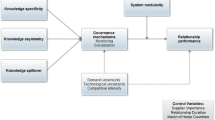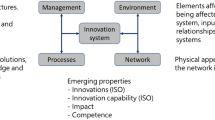Abstract
As little attention has been paid to the relationship between modularity and near decomposability, extant studies have not unveiled the impact of modularity on incremental innovation completely. We argue that the modular structure is a special case of nearly decomposable structure, in which the interdependencies between modules are specified by design rules, and the degree of modularity is defined by the level of near decomposability and the extent to which intermodule dependencies are specified. The results of our simulation experiments show that in the term of near decomposability, the increase of modularity leads to higher innovation advantage in the short term, but effective communication between modules can help systems with moderate and low modularity gain more innovation benefits in the long term; in the aspect of design rules, modularization may restrict the search space of the incremental innovation within each module, but under some conditions the option value of modularity may offset or even exceed the restriction effect of design rules.
Similar content being viewed by others
Explore related subjects
Discover the latest articles, news and stories from top researchers in related subjects.References
Altenberg L (1997) NK fitness landscapes. In: Back T, Fogel D, Michalewicz Z (eds) The handbook of evolutionary computation. Oxford University Press, Oxford, pp B2.7:5–B2.7:10
Baldwin CY (2008) Where do transactions come from? Modularity, transactions, and the boundaries of firms. Ind Corp Change 17(1):155–195
Baldwin CY, Clark KB (1997) Managing in the age of modularity. Harv Bus Rev 75(5):84–93
Baldwin CY, Clark KB (2000) Design rules: the power of modularity. MIT Press, Cambridge
Browning TR (2001) Applying the design structure matrix to system decomposition and integration problems: a review and new directions. IEEE Trans Eng Manag 48(3):292–306
Brusoni S, Prencipe A (2001) Unpacking the black box of modularity: technologies, products and organizations. Ind Corp Change 10:179–205
Brusoni S, Marengo L, Prencipe A, Valente M (2007) The value and costs of modularity: a problem-solving perspective. Eur Manag Rev 4:121–132
Carroll T, Burton RM (2000) Organizations and complexity: searching for the edge of chaos. Comput Math Organ Theory 6(4):319–337
Chesbrough HW (2003) Towards a dynamics of modularity: a cyclical model of technical advance. In: Prencipe A, Davies A, Hobday M (eds) The business of systems integration. Oxford University Press, New York, pp 174–198
Ethiraj SK, Levinthal DA (2004a) Bounded rationality and the search for organizational architecture: an evolutionary perspective on the design of organizations and their evolvability. Adm Sci Q 49:404–437
Ethiraj SK, Levinthal DA (2004b) Modularity and innovation in complex systems. Manag Sci 50(2):159–173
Ethiraj SK, Levinthal DA, Roy RR (2008) The dual role of modularity: innovation and imitation. Manag Sci 54(5):939–955
Diamantopoulos A, Riefler P, Roth KP (2008) Advancing formative measurement models. J Bus Res 61(12):1203–1218
Fleming L, Sorenson O (2001a) Technology as a complex adaptive system: evidence from patent data. Res Policy 30(7):1019–1039
Fleming L, Sorenson O (2001b) The dangers of modularity. Harv Bus Rev 79(8):20–21
Fleming L, Sorenson O (2003) Navigating the technology landscape of innovation. MIT Sloan Manag Rev 44(2):15–23
Fleming L, Sorenson O (2004) Science as a map in technological search. Strateg Manag J 25(8–9):909–928
Frenken K (2006) A fitness landscape approach to technological complexity, modularity, and vertical disintegration. Struct Change Econ Dyn 17(3):288–305
Gavetti G, Levinthal DA (2000) Looking forward and looking backward: cognitive and experiential search. Adm Sci Q 45(1):113–137
Gavetti G (2005) Cognition and hierarchy: rethinking the microfoundations of capabilities’ development. Organ Sci 16(6):599–617
Goldberg DE (1989) Genetic algorithms in search, optimization and machine learning. Addison-Wesley Longman, Reading
Helfat CE, Eisenhardt KM (2004) Inter-temporal economies of scope organizational modularity, and the dynamics of diversification. Strateg Manag J 25(13):1217–1232
Henderson RM, Clark KB (1990) Architectural Innovation: the reconfiguration of existing product technologies and the failure of established firms. Adm Sci Q 35(1):9–30
Holland JH (1992) Adaptation in natural and artificial systems: an introductory analysis with applications to biology, control and artificial intelligence, 2nd edn. MIT Press, Cambridge
Jarvis CB, MacKenzie SB, Podsakoff PM (2003) A critical review of construct indicators and measurement model misspecification in marketing and consumer research. J Consum Res 30(2):199–218
Karim S (2006) Modularity in organizational structure: the reconfiguration of internally developed and acquired business units. Strateg Manag J 27(9):799–823
Kauffman SA (1993) The origins of order: self-organization and selection in evolution. Oxford University Press, New York
Kogut B, Zander U (1992) Knowledge of the firm, combinative capabilities, and the replication of technology. Organ Sci 3(3):383–397
Kogut B, Zander U (1996) What firms do? Coordination, identity, and learning. Organ Sci 7(5):502–518
Langlois RN (2002) Modularity in technology and organization. J Econ Behav Organ 49(1):19–37
Langlois RN, Robertson PL (1992) Networks and innovation in a modular system: lessons from the microcomputer and stereo component industries. Res Policy 21:207–313
Lenox MJ, Rockart SF, AY Lewin (2006) Interdependency, competition, and the distribution of firm and industry profits. Manag Sci 52(5):757–772
Levinthal DA (1997) Adaptation on rugged landscapes. Manag Sci 43(7):934–950
Levinthal DA, March JG (1993) The myopia of learning. Strateg Manag J 14(2):95–112
March JG, Simon H (1958) Organizations. Wiley, New York
Marengo L, Dosi G, Legrenzi P, Pasquali C (2000) The structure of problem-solving knowledge and the structure of organizations. Ind Corp Change 9(4):757–788
Nelson RR, Winter SG (1982) An evolutionary theory of economic change. Harvard University Press, Cambridge
Parnas DL, Clements PC, Weiss DM (1985) The modular structure of complex systems. IEEE Trans Softw Eng 11(3):259–266
Pil FK, Cohen SK (2006) Modularity: implications for imitation innovation, and sustained advantage. Acad Manag Rev 31(4):995–1011
Press K (2008) Divide to conquer? Limits to the adaptability of disintegrated, flexible specialization clusters. J. Econ Geogr 8(4):565–580
Rivkin JW, Siggelkow N (2003) Balancing search and stability: interdependencies among elements of organizational design. Manag Sci 49(3):290–311
Rivkin JW, Siggelkow N (2007) Patterned interactions in complex systems: implications for exploration. Manag Sci 53(7):1068–1085
Sanchez R, Mahoney JT (1996) Modularity flexibility, and knowledge management in product and organization design. Strateg Manag J 17:63–76 (winter special issue)
Schilling M (2000) Towards a general modular systems theory and its application to interfirm product modularity. Acad Manag Rev 25(2):312–334
Schumpeter JA (1934) The theory of economic development. Harvard University Press, Cambridge
Scott WR (1992) Organizations: rational, natural and open systems. Englewood Cliffs, Prentice-Hall
Siggelkow N, Levinthal DA (2003) Temporarily divide to conquer: centralized, decentralized, and reintegrated organizational approaches to exploration and adaptation. Organ Sci 14(6):650–669
Simon HA (1962) The architecture of complexity. Proc Am Philos Soc 106:467–482
Simon HA (1976) Administrative behavior: a study of decision-making processes in administrative organization, 3rd edn. Free Press, New York
Simon HA (1995) Organizations and markets. J Public Adm Res Theory 5(3):273–294
Simon HA (2002) Near decomposability and the speed of evolution. Ind Corp Change 11(3):587–599
Sorenson O (2002) Interorganizational complexity and computation. In: Baum JAC (ed) Companion to organizations. Blackwell, Oxford, pp 664–685
Sorenson O (2003) Interdependence and adaptability: organizational learning and the long-term effect of integration. Manag Sci 49(4):446–463
Steward DV (1981) The design structure system: a method for managing the design of complex systems. IEEE Trans Eng Manag 28(3):71–74
Thompson JD (1967) Organizations in action. McGraw-Hill, New York
Ulrich K (1995) The role of product architecture in the manufacturing firm. Res Policy 24(3):419–440
von Hippel E (1990) Task partitioning: an innovation process variable. Res Policy 19(5):407–418
Williamson OE (1991) Comparative economic organization: the analysis of discrete structural alternatives. Adm Sci Q 36(2):269–296
Yayavaram S, Ahuja G (2008) Decomposability in knowledge structures and its impact on the usefulness of inventions and knowledge-base malleability. Adm Sci Q 53(2):333–362
Zollo M, Winter SG (2002) Deliberate learning and the evolution of dynamic capabilities. Organ Sci 13(3):339–351
Author information
Authors and Affiliations
Corresponding author
Additional information
This research was supported by National Science Foundation of China under grant No. 70671091 and 70732001. The prior version of this paper was presented at the 2009 annual meeting of the Academy of Management in Chicago.
Rights and permissions
About this article
Cite this article
Zhang, G., Gao, R. Modularity and incremental innovation: the roles of design rules and organizational communication. Comput Math Organ Theory 16, 171–200 (2010). https://doi.org/10.1007/s10588-010-9071-5
Published:
Issue Date:
DOI: https://doi.org/10.1007/s10588-010-9071-5




